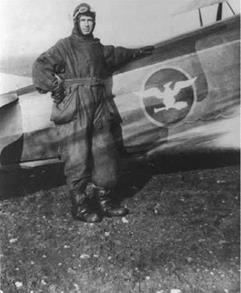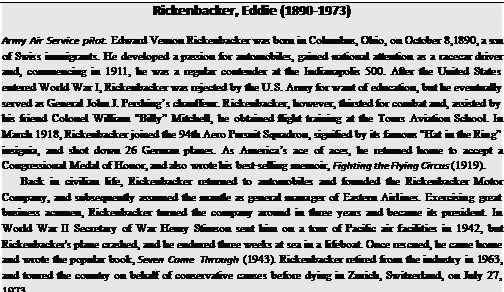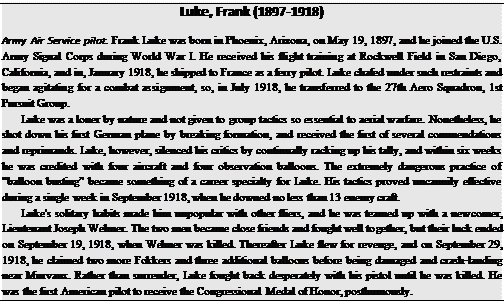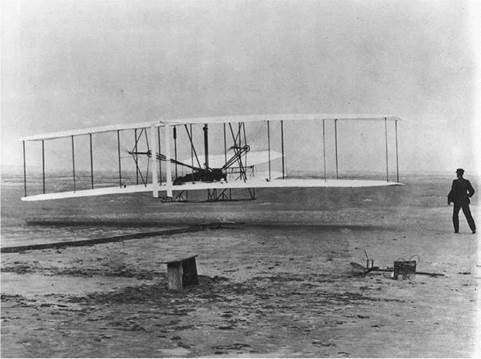1862
|
APRIL 16 Over Virginia, Professor Thaddeus S. C. Lowe uses a hydrogen balloon to assist Union General Fitz-John Porter. However, his tether line breaks and he drifts over Confederate territory, but Lowe waits for a breeze to blow him back across Union lines and he |
descends and relays his findings to Union headquarters. MAY 31—June 1 Over Virginia, the hydrogen balloon Intrepid is flown to convey military intelligence during the Battle of Fair Oaks (Seven Pines). |
|
1892 |
|
|
January In Paris, France, Lieutenant William A. Glassford purchases a balloon for the Signal Corps. It is subsequently named the General Myer and transferred to Fort Riley, Kansas, for the Signal Corps. |
MAY 6 At Quantico, Virginia, Samuel P. Langley launches Aerodrome No. 5, the first pilotless, engine-driven, heavier-than-air craft. The device manages to fly from a catapult mounted on a houseboat for a distance of3,300 feet and 2,300 feet in two flights. |
|
1894 |
|
|
At Fort Logan, Colorado, the Signal Corps balloon detachment arrives from |
Fort Riley, Kansas, in search of better weather conditions. |
1917JANUARY 6 In Washington, D. C., the findings of a joint Army and Navy Board encourages the secretaries of War and the Navy to acquire several lighter-than-air ships based on the proven German Zeppelin design. Funding is also split between the two services, and a new board of three officers from each service arises to ensure close cooperation. JANUARY 9 At San Diego, California, Captain Henry H. Arnold is dispatched to Panama as commander of the 7th Aero Squadron, which, presently, possesses neither bases nor airplanes. At Fort Kamehameha, Hawaii, Captain John F. Curry assumes command of the new 6th Aero Squadron. ■
FEBRUARY 3 In Washington, D. C., the United States formally severs diplomatic relations with Germany in response to the latter’s resumption of unrestricted submarine warfare against neutral shipping. FEBRUARY 10 The National Advisory Committee for Aeronautics (NACA) founds a patent subcommittee to help preclude legal actions threatening the entire industry. FEBRUARY 19 Lieutenant Colonel John B. Bennett assumes command ofthe Aviation Service, Signal Corps, while his predecessor, Lieutenant Colonel George O. Squier, gains appointment as chief signal officer. February 28 At North Island, San Diego, California, the first successful experiments with radiotelephones between aircraft and ground stations transpire. Previous attempts in aerial communication utilized telegraphs. MARCH 13 Brigadier General George O. Squier, chief signal officer, authorizes the Intelligence subdivision of the Signal Corps; this marks the birth of Army Air Intelligence. April 6 When the United States enters World War I, the Aviation Section of the Signal Corps consisted of 35 pilots, 55 training aircraft, and 1,987 enlisted men. Such numbers are woefully inadequate by European standards. April 30 In Europe, Captain William “Billy” Mitchell becomes the first officer of the Army Air Service to fly over enemy territory in a French aircraft; he becomes an outspoken spokesman for American air power. May 5 In Washington, D. C., the secretaries of War and the Navy consent to a “joint technical board” assembled for the standardizing the design and performance specifications of all forthcoming aircraft. May 12 At San Diego, California, Captain W. A. Robertson sets a new altitude record of 17,230 feet over the North Island Flying School. May 16 The Council of National Defense establishes the Aircraft Production Board and entrusts it to Howard Coffin, former CEO of the Hudson Motor Car Company. This body acts in an advisory capacity relative to aircraft development and procurement and signals a massive buildup of American aerial strength for use in World War I. May 23 French premier Alexandre Ribot requests 5,000 American pilots, 4,500 aircraft, and 50,000 aircraft mechanics to assist the Allied war effort, and Major Benjamin D. Foulois is tasked with drawing up a plan for the government to achieve these goals. May 26 Signal Corps Major Townsend F. Dodd gains appointment as AEF aviation officer to General John J. Pershing’s staff. This is a boost to the Aviation Section’s reputation. May 29 In Washington, D. C., Colonel Edwin Deeds collaborates with several designers to conceptualize a standardized engine to American military aircraft. These endeavors culminate in the famous 12-cylinder, 400-horsepower Liberty engine, of which 15,000 are manufactured for the war effort. JUNE 2 The Aviation Section, Army Signal Corps, is redesignated the Airplane Division. June 4 The Aircraft Production Board and the Joint Technical Board on Aircraft authorize five prototypes of 8- and 12- cylinder Liberty motors. These are exceptionally conservative in design, and expressly conceived for mass production. June 17 The Aircraft Production Board dispatches a joint Army-Navy aviation board under Major Raynal C. Bolling to Europe to study and possibly incorporate European production techniques in aircraft production at home. June 30 In France, Lieutenant Colonel William “Billy” Mitchell replaces Major Townsend F. Dodd as Aviation Officer, American Expeditionary Force (AEF). July 4 Rantoul, Illinois, hosts the first military airfield in the United States for training purposes. Presently, the Army Air Service possesses only 55 obsolete aircraft. It ends the war with 16,801 combat aircraft in service, mostly obtained from France. JULY 20 In the Shiloh Valley Township, Illinois, Scott Field is christened by the War Department in honor of Corporal Frank S. Scott, who was killed in a flying accident on September 28, 1912. This is the only base named after an enlisted man. JULY 23 Command of the Airplane Division, Army Signal Corps, passes to Major Benjamin D. Foulois. July 24 In Washington, D. C., Congress makes its first large appropriation for the Army Aviation Section, which receives $640 million. Significantly, the 4,500 new military aircraft manufactured in the United States are either naval patrol craft or army trainers powered by a reliable motor designed by the Packard Motor Car Company, the so-called “Liberty Engine,” of which 15,131 are constructed by war’s end. Manufacturers Aircraft Association is created to implement a cross-licensing agreement, whereby member companies could access all patents at fixed low rates. This obviates the threat of lawsuits. JULY 26 The Army-Navy Airship Board endorses a proposal by the Bureau of Mines to allot a grant of $100,000 and construct a small plant to produce helium in the United States. July 27 A British-built De Havilland DH-4 two-seat bomber arrives in the United States to facilitate production of an American version. Roughly 4,500 are manufactured stateside with the popular 12-cylinder Liberty engine, but only a handful enter combat operations. JULY 28 At Liverpool, England, the 29th Provisional Construction Squadron becomes the first American aero squadron deployed in Europe during the war. AUGUST 5 In Columbus, New Mexico, the 1st Aero Squadron under Major Ralph Royce begins transferring its personnel to training facilities in Avord, France. AUGUST 13 In New York, men and equipment of the 1st Aero Squadron set sail for Europe under Major Ralph Royce. This is the first such unit dispatched to the Western Front. AUGUST 21 The Model F, constructed by the L. W.F. Engineering Company, becomes the first airplane powered by the Liberty engine. AUGUST 22 In the United States, mass production of air-to-ground radiotelephones commences. AUGUST 25 The 12-cylinder, 300-horsepower Liberty engine passes its acceptance test with flying colors and is ordered into production as America’s standard aircraft engine. SEPTEMBER 3 Brigadier General William L. Kenly becomes chief of air service on the AEF staff, an act granting American aerial activities greater recognition and significance. Lieutenant Colonel William “Billy” Mitchell also becomes air commander of the Zone of the Advance. SEPTEMBER 13 In France, the 1st Aero Squadron is the first aviation unit to reach operational status and begin training with the American Expeditionary Force (AEF). They are mostly involved in artillery spotting and tactical reconnaissance. OCTOBER 16 At Langley Field, Virginia, radiotelephone devices installed on two aircraft transmit and receive signals at distances of 25 miles; those sent to ground stations can be heard 45 miles away. OCTOBER 18 At Dayton, Ohio, the Signals Corps assigns McCook Field to serve as its new testing center to facilitate aeronautical research and development in the rapidly changing field of military aviation. In Washington, D. C., the Aviation Medical Research Board is created by the U. S. Army Signal Corps. OCTOBER 21 At Buffalo, New York, a new 12-cylinder Liberty engine enjoys a successful debut by powering a Curtiss HS-1 flying boat. The engine is adopted for use in both Army and Navy aircraft with great success. OCTOBER 29 At McCook Field, Dayton, Ohio, test pilot Howard Rinehart pilots the first American-manufactured De Havilland DH-4 bomber. This is the first of several thousand constructed during the war years, although only a handful actually see combat. NOVEMBER 7 Over France, Eugene J. Bullard is the first African American pilot to shoot down a German aircraft during World War I. Due to the intense racism encountered in America, Bullard joined the French army and subsequently flew with a French squadron. NOVEMBER 27 Newly promoted Brigadier General Benjamin D. Foulois gains appointment as AEF chief of the air service under General John J. Pershing. December 22 At Cambridge, Massachusetts, an Aerography School begins instruction at the Massachusetts Institute ofTechnology; however, a major portion of the curriculum unfolds at the Blue Hill Observatory, Harvard University. Fifty- five men have passed through the program by war’s end. 1933JANUARY 3 In Washington, D. C., General Douglas A. MacArthur instructs the Air Corps to conduct all land-based operations in defense of the United States and all overseas possessions. FEBRUARY 10 Major Hugh J. Knerr, chief of the Field Service Section, Air Materiel Division, promulgates a scheme whereby each of four regional air depots will possess its own air transport squadron to haul men and equipment between the depots. They can also transport army troops on maneuvers. OCTOBER 11 In Washington, D. C., a board headed by Major General Hugh A. Drum recommends creation of a General Headquarters Air Force (GHQ). This would consists of 1,000 aircraft and operate independently of all ground units; the report is subsequently approved by Secretary of War George H. Derm NOVEMBER 20 After departing from Akron, Ohio, Lieutenant Commander Thomas G. W. Settle and Major Chester L. Fordney are the first Americans to take a balloon to an altitude of 61,237 feet. November 27 The first production Martin B-10 bomber is accepted into the Army Air Corps. This streamlined, allmetal monoplane features retractable landing gear, an internal bomb bay, and a power nose turret. It flies faster than contemporary fighters of the day. December 13 In Washington, D. C., Major Bryan Freeburg receives the first Air Mail Flyer’s Medal of Honor from President Franklin D. Roosevelt. 1898 |
|
MARCH 25 In Washington, D. C., Assistant Secretary of the Navy Theodore Roosevelt recommends to the Secretary |
of the Navy that “scientific officers” be appointed to investigate the military applications of Dr. Samuel P. Langley’s |
|
experimental “flying machine” under development. APRIL 29 The first joint Army-Navy aeronautics board issues a report enunciating its findings relative to Dr. Samuel |
Langley’s flying machine. This device is a developmental model with no practical military application, but they nonetheless recommend funding for continuing experimentation. |
|
1900 |
|
|
OCTOBER At Kitty Hawk, North Carolina, brothers Wilbur and Orville Wright |
successfully test their manned glider design. |
|
1901 |
|
|
June 26—27 In Dayton, Ohio, the Wright brothers confer with aeronautical theorist Octave Chanute over the concept of “flying machines.” |
JULY 27 At Kitty Hawk, North Carolina, the Wright brothers’ 1901 Glider is successfully launched from sand dunes for the first time. |
|
1902 |
|
|
September 19 At Kitty Hawk, North Carolina, the Wright brothers begin testing their new, larger glider with technical information received from Octave Chanute. The device flies |
consistent with calculations that had been figured in advance. That winter the Wrights begin construction of a special four-cylinder motor and propellers for their glider. |














